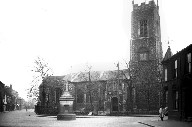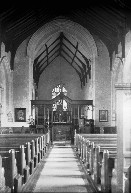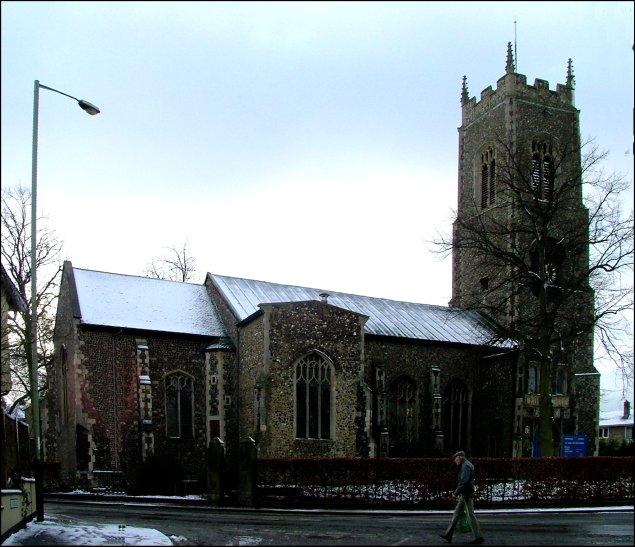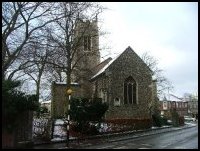| |
|
St John
Sepulchre, Norwich
| St John Sepulchre, or, to
give it its full joint dedication, St John the
Baptist and the Consecration of the Holy
Sepulchre, may very well be the best known of all
the Norwich churches. Norwich's central City
railway station was destroyed in the War, but in
any case the main station has long been that in
the suburb of Thorpe, because that was the
station where the trains from London arrived.
Today, it is Norwich's only station; alas, from
Thorpe you cannot see the Cathedral; indeed, you
cannot see any of Norwich's 30-odd surviving
medieval churches, except this one. St John
Sepulchre rides high on the bluff of Ber Street,
a beacon for anyone arriving in the city, a
citadel on a hill. The top of its tower is one of
the highest points in the city. Transepted, it
sprawls in its tight churchyard, far less content
than its fellow medieval churches to cower below
tall neighbours. |
|
.jpg) |
 |
|
Like most of the other
Norwich city centre churches it is, of course,
redundant; at least, as far as its Catholic and
then Anglican past is concerned. Although within
the city walls, it was the medieval church which
was furthest from the castle and the cathedral,
the heart of a fiercely independent parish, South
Conesford, near to the Berestrete gate. Even in
the Middle Ages, it was the first Norwich church
that visitors from London saw. In George Plunkett's photograph from
the 1930s on the left, it bestrides the end of
Ber Street like a colossus, seeming to say 'Thus
far and no further'. The parish cross outside of
it has now gone (where?) and this is a busy
traffic junction on the edge of the city centre.
|
St John's character comes from its distance
from the city centre and its proximity to the inner
suburbs; but this was also its downfall. To the south of
the church is the suburb of Lakenham, virtually an
inner-city area, and in the 1840s that parish was
populous enough to build a chapel of ease, St Mark, not
200 metres from St John. As the population of Conesford
fell to warehouses and factories, so Lakenham expanded,
until there were simply no people left to attend St John.
It was finally declared redundant in 1970 as a result of
the Brooke Report.
| St
John today is home to the Norwich branch of that
curious denomination, the English Orthodox
church. Hardly a denomination at all really,
since its churches are, appropriately in this
case, fiercely independent of each other. The
church is now rededicated to St John the
Theologian, the Orthodox name for the Saint we in
the west call St John the Divine. Born as
part of the Russian Orthodox movement, bolstered
by the minority of refugees from the Church of
England who, at the time of the ordination of
women Priests, did not wish to become Catholics,
and supported today in an England that has seen
an influx of thousands and thousands of workers
from the former Soviet Bloc, the English Orthodox
movement is a fascinating example of the way in
which theological currents are rarely
predictable.
|
|
 |
|
.jpg) |
Inside the church there are few medieval
survivals; St John was given a thorough going over in the
19th century. But there is a good, typically rural East
Anglian font, and you can see it in Chris Harrison's
image, as well as some other features of the church. But
be aware if you are a fan of John Oldrid Scott that his
reredos here is now behind the iconostasis, and may not
be approached by anyone except an Orthodox Priest, who
will be understandably reluctant to take a photograph of
it for you.
Simon Knott, January 2006
|
|
|



.jpg)
.jpg)
.jpg)